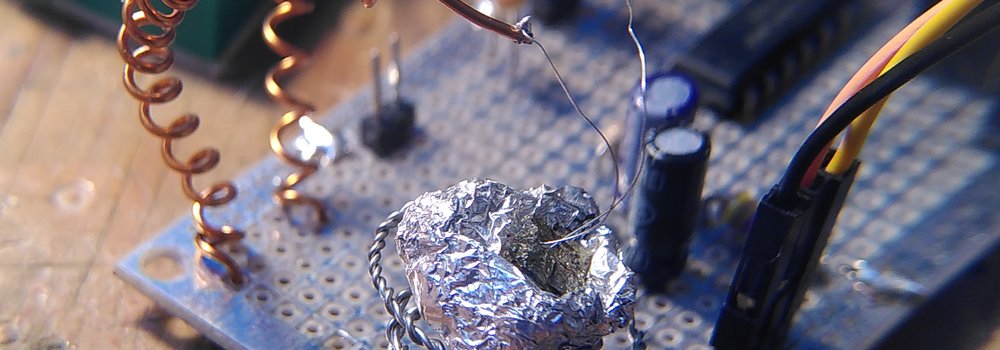We were recently awarded funding to do two more Organised Atoms workshops by the Royal Society of Chemistry. The idea with this project is to ground digital technology back into the earth that it all comes from, by exploring the properties of semiconducting crystals in Cornish mine waste by playing with synthesiser circuits. After running the first workshop during the Flamm Festival, our next challenge is to try using the sounds crystals make alongside other scientific identification techniques like streak, scratch and colour - and do it with similar groups of local people as we did before.
We are currently finalising potential locations, part of the consideration is whether we can find a place where we can do both the fossicking and sound workshops on the same day. Some of the abandoned mines have found quite different uses in recent years, as well as maintaining a respectable supply of promising rocks, so watch this space!
One of the first things to investigate in terms of practical improvements was the design of the crystal holder. This is a mechanism that creates 'junctions' between two metal 'cat's whisker' conductors, the crystal substance itself and the thin layers of oxidisation between them that provides our naturally formed semiconductor.
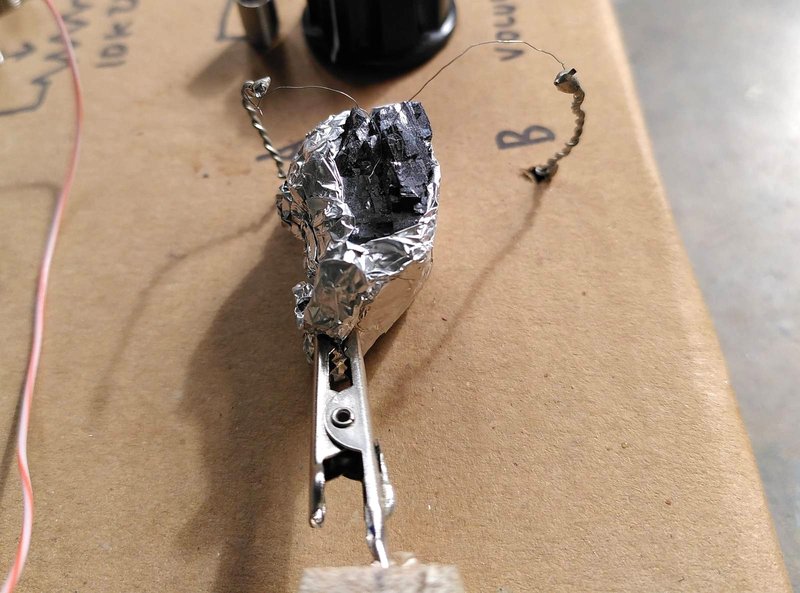
This is a photo from our workshop setup (the Cardboard Crystal Synthesiser version 1). The galena crystal is wrapped in aluminum foil and gripped by a miniature crocodile clip while it is being tickled by two thin wires. This setup was able to accommodate quite a range of sizes of crystals, including where the crystal was attached to it's matrix rock - but it wasn't great in terms of reliability or ease of use.
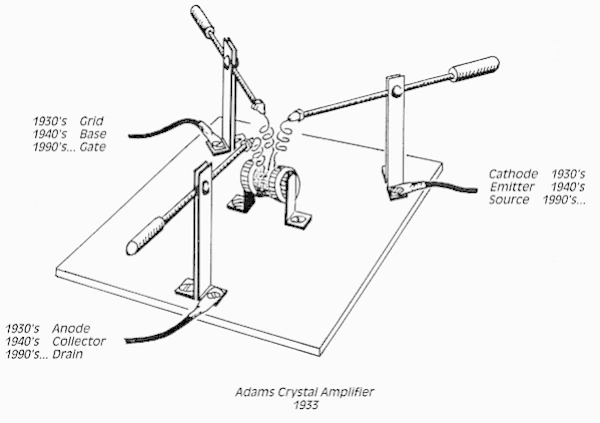
This is a diagram of a version of this from 1933 - possibly the first transistor, but as it was discovered by a 13 year old Robert Adams, it's the version by Bell Labs (14 years later) that gets the historical mentions and Nobel prizes.
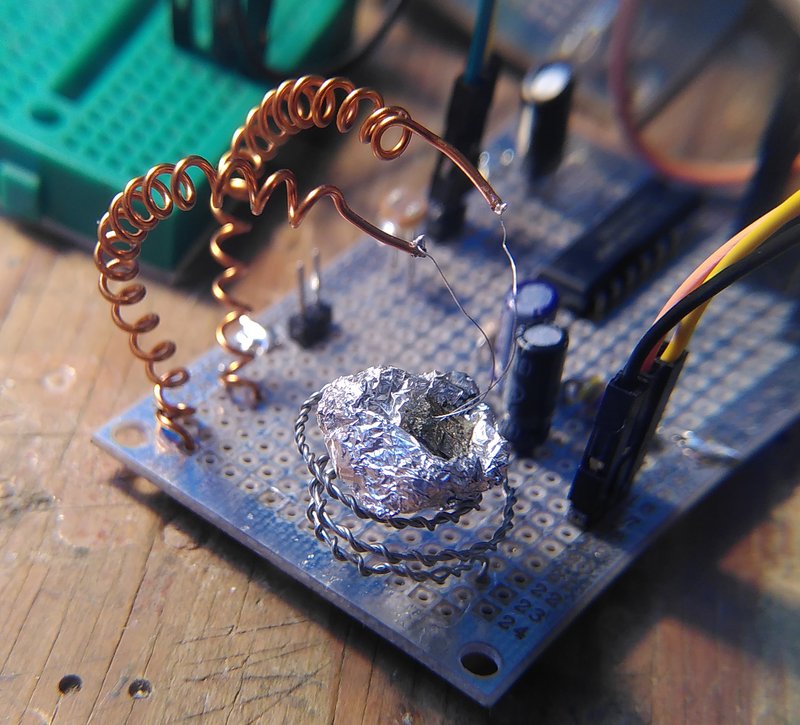
This was the first attempt at a new approach - to remove the crocodile clip and wrap the foil in a sprung wire and use coils to position the cat's whiskers. It takes up less space, and it can be mounted directly on a printed circuit board - but the problem here is that it is still quite difficult to adjust the fine wires so they actually touch the crystal and adjust the pressure when they do.
After getting hold of some more materials for our semiconductor factory (some conductive pins, 8mm copper pipe and some flexible plastic piping) there was a bit of a prototyping to be done (the photos are a bit rubbish, sorry!):

The third version works well because it holds the crystal more firmly, the wires are much closer, shorter, and less likely to move around - and the pins give you a bit of extra adjustment. You can rotate them as well as move them in and out to provide a way to adjust the pressure on the crystal. From experimenting it seems this pressure control is the most significant factor in creating good semiconducting junctions.
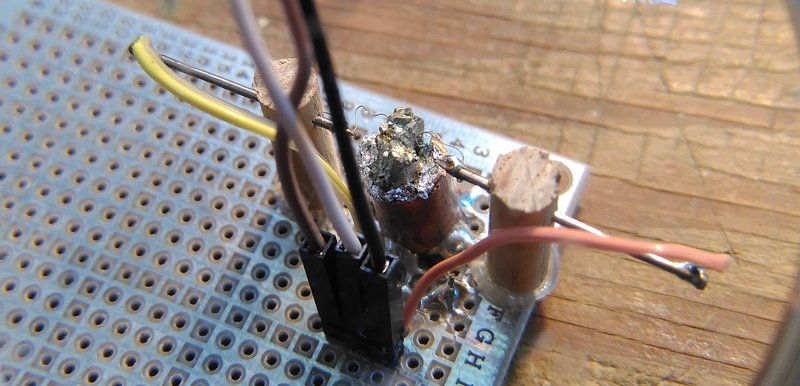
There is still a bit more development to do, but now we had a more reliable setup, we could attempt to better understand what might be happening when we use it in a circuit like this. We'd spent quite a bit of time analysing the diode behavior before, looking at a single junction. This was important to show we are able to prove a semiconducting process is happening, and for example, build a working AM radio using it. Adding a second cat's whisker 'worked' in the sense that it did some very strange things to the sounds we were making during our workshop and open lab - but we never had time to look further at this more scientifically.
The basic circuit we've been playing with changes the pitch of a square wave oscillator with another signal. The two circuit diagrams are below - with a standard transistor version on the left and our attempt with a (pyrite in this case) crystal on the right. We are feeding in a slow sine wave to the circuit's input - which fluctuates between 0V and 2V at 1Hz.
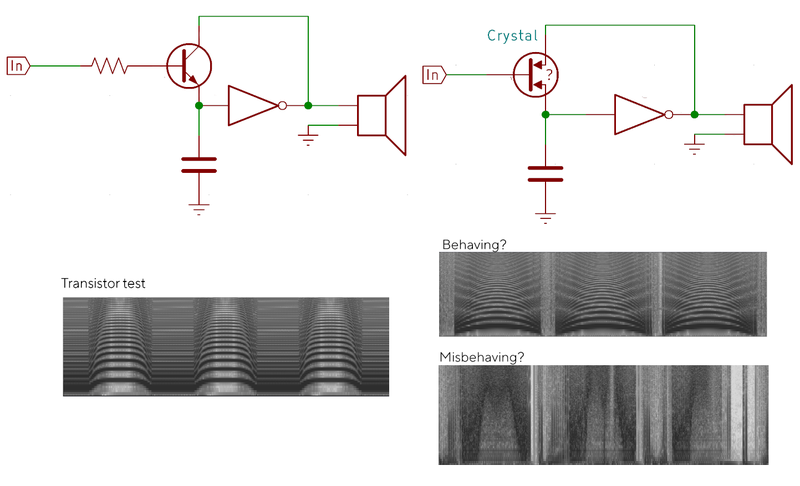
Here are some frequency plots of what we are getting from the output of the two circuits - with the 'control' on the left using a normal transistor the pitch rises and falls predictably every second (the lines on the plot rise up and down). On the right, on the top plot we see something a bit similar - the pitch rises and falls in the same way, just to a different amount. I thought this was a bit more significant than it turns out to be, as going a little deeper it seems that it's possible to get similar results by simply using resistors here - so unfortunately while it's a similar result to the transistor, it's not really something that ultimately proves we have a semiconductor action. What might be more interesting on the crystal version is where it cuts off oscillation below a certain voltage threshold, the flat lighter areas between the rises. This may indicate a voltage drop being caused by the crystal. This region is also quite noisy and unpredictable - which is the sort of effect we were getting audibly as well.
The frequency plot underneath that shows results from the cat's whiskers in a different position, and is much more chaotic - the sine wave coming in has an effect on the sound, but much of the predicable character of the square wave tone is gone. It's this noise which may show that something more interesting is happening, you often hear characteristic pops and hissing when searching the surface of a crystal in this sort of circuit. My theory is that we have two sources of uncertainty - chaos in the digital inverter chip when pushed to extremes, and the interactions between the atoms in the mine waste minerals (and the interactions between them). There are other weirdnesses we get that need to be examined too, such as long duration changes - perhaps influenced by heat or even light falling on the semiconductor, and sudden phase shifts where long periods of stability in the sound are suddenly changed by tiny variations in voltage.
So this is a start rather than anything conclusive, we are now ordering parts for a new build of cardboard synthesisers, but we'll keep investigating this, and recording new sounds too - as they may give rise to new ideas for circuits to try out during the workshop.

